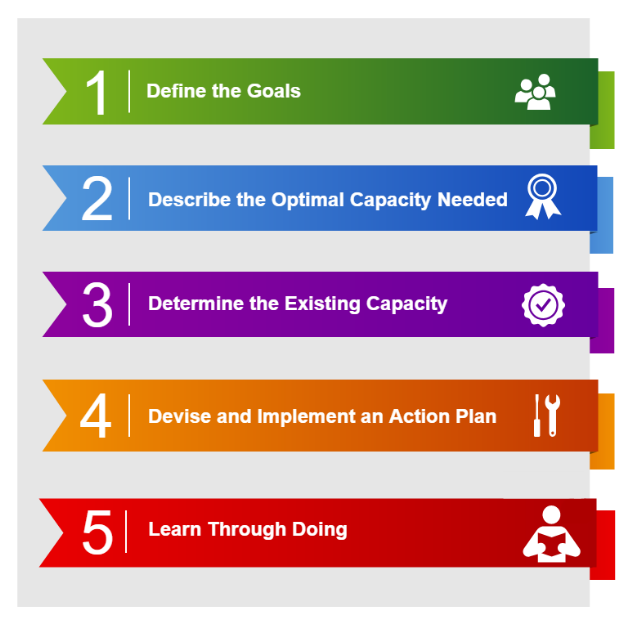The Centre for Capacity Research has developed a ‘5-step’ approach to capacity strengthening that has been widely implemented across multiple programme types. This is just one of the many activities that the Centre for Capacity Research engage in and it is briefly described below.
1. Define the goals
It is important to have a defined goal of the capacity strengthening programme to ensure that the intervention addresses identified priorities and to harmonise the expectations of the key stakeholders to promote sustainability. The
2. Describe the ‘optimal’ capacity needed
A broad and systematic search for relevant evidence and current good practice is needed to cover all areas relating to the capacity strengthening goal. This is then developed into the optimal set of capacities against which the capacity strengthening programme can be benchmarked. The evidence collected could be through a review of peer reviewed publications and grey literature (including reports, guidelines and recommendations) and consultations with expert groups. The description of optimal capacity is then used to develop a practical set of data collection tools for use in step 3.
3. Determine the existing capacity gaps
This is the primary data collection step. Through in-depth interviews, document reviews and observation, a full picture can be built of where capacity gaps exist in the target setting and where the most attention is required. Developing an interview guide is good practice to ensure that all areas relating to the capacity strengthening goals (step 2) are included.
4. Devise and implement an action plan
An action plan is now developed to prioritise and address the identified capacity gaps. The necessary actions required to meet those gaps including the indicators of completion, the person responsible for the action(s), and the date to review progress are also included.
5. Regular monitoring of the action plan – learn through doing

Building in processes to regularly monitor the implementation of the action plan will help to ensure that the agreed activities occur. As time progresses, priorities can be reassessed as capacity gaps are strengthened and staff change. Being flexible and allowing the action plan to be adapted and the indicators refined, with new actions added and closed as required, is good practice.
For more information: Bates, I., Boyd, A., Smith, H. et al. A practical and systematic approach to organisational capacity strengthening for research in the health sector in Africa. Health Res Policy Sys 12, 11 (2014).